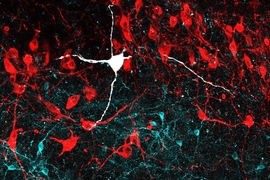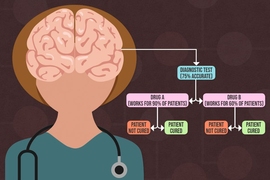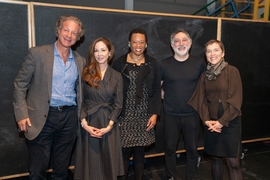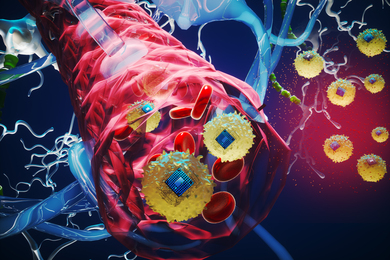K. Guadalupe Cruz’s path into neuroscience began with storytelling.
“For me, it was always interesting that we are capable of keeping knowledge over so many generations,” says Cruz, a PhD student in the Department of Brain and Cognitive Sciences. For millennia, information has been passed down through the stories shared by communities, and Cruz wanted to understand how that information was transferred from one person to the next. “That was one of my first big questions,” she says.
Cruz has been asking this question since high school and the urge to answer it led her to anthropology, psychology, and linguistics, but she felt like something was missing. “I wanted a mechanism,” she explains. “So I kept going further and further, and eventually ended up in neuroscience.”
As an undergraduate at the University of Arizona, Cruz became fascinated with the sheer complexity of the brain. “We started learning a lot about different animals and how their brains worked,” says Cruz. “I just thought it was so cool,” she adds. That fascination got her into the lab and Cruz has never left. “I’ve been doing research ever since.”
A sense of space
If you’ve ever seen a model of the brain, you’ve probably seen one that is divided into regions, each shaded with a different color and with its own distinct function. The frontal lobe in red plans, the cerebellum in blue coordinates movement, the hippocampus in green remembers. But this is an oversimplification.
“The brain isn’t entirely modular,” says Cruz. Different parts of the brain don’t have a single function, but rather a number of functions, and their complexity increases toward the front of the brain. The intricacy of these frontal regions is embodied in their anatomy: “They have a lot of cells and they’re heavily interconnected,” she explains. These frontal regions encode many types of information, which means they are involved in a number of different functions, sometimes in abstract ways that are difficult to unravel.
The frontal region Cruz is bent on demystifying is the anterior cingulate cortex, or ACC, a part of the brain that wraps around the corpus callosum, which divides the outer layers of the brain into left and right hemispheres. Working with mice in Professor Mriganka Sur’s lab, Cruz looks at the role of the ACC in coordinating different downstream brain structures in orientating tasks. In humans, the ACC is involved in motivation, but in mice it has a role in visually guided orienting.
“Everything you experience in the world is relative to your own body,” says Cruz. Being able to determine where your body is in space is essential for navigating through the world. To explain this, Cruz gives the example of driver making a turn. “If you have to do a left turn, you’re going to need to use different information to determine whether you’re allowed to make that turn and if that’s the right choice,” Cruz explains. The ACC in this analogy is the driver: It has to take in all the information about the surrounding world, decide what to do, and then send this decision to other parts of the brain that control movement.
To study this, Cruz gives mice a simple task: She shows them two squares of different shades on a screen and asks them to move the darker square. “The idea is, how does this area of the brain take in this information, compare the two squares and decide which movement is correct,” she explains. Many researchers study how information gets to the ACC, but Cruz is interested in what happens after the information arrives, focusing on the processing and output ends of the equation, particularly in deciphering the contributions of different brain connections to the resulting action.
Cruz uses optogenetics to figure out which areas of the brain are necessary for decision-making. Optogenetics is a technique that uses light to turn on or off previously targeted neurons or areas of the brain. “This allows us to causally test whether parts of a circuit are required for a behavior or not,” she explains. Cruz distills it even further: “But mostly, it just lets us know that if you screw with this area, you’re going to screw something up.”
Community builder
At MIT, Cruz has been able to ask the neuroscience questions she’s captivated by, but coming to the Institute also made her more aware of how few underrepresented minorities, or URMs, there are in science broadly. “I started realizing how academia is not built for us, or rather, is built to exclude us,” says Cruz. “I saw these problems, and I wanted to do something to address them.”
Cruz has focused many of her efforts on community building. “A lot of us come from communities that are very ‘other’ oriented, and focused on helping one another,” she explains. One of her initiatives is Community Lunch, a biweekly casual lunch in the brain and cognitive sciences department. “It’s sponsored by the School of Science for basically anybody that’s a person of color in academia,” says Cruz. The lunch includes graduate students, postdocs, and technicians who come together to talk about their experiences in academia. “It’s kind of like a support group,” she says. Connecting with people that have shared experiences is important, she adds: “You get to talk about things and realize this is a feeling that a lot of people have.”
Another goal of Cruz’s is to make sure MIT understands the hurdles that many URMs experience in academia. For instance, applying to graduate school or having to cover costs for conferences can put a real strain on finances. “I applied to 10 programs; I was eating cereal every day for a month,” remembers Cruz. “I try to bring that information to light, because faculty and administrators have often never experienced it.”
Cruz also is the representative for the LGBT community on the MIT Graduate Student Council and a member of LGBT Grad, a student group run by and for MIT’s LGBT grad students and postdocs. “LGBT Grad is basically a social club for the community, and we try to organize events to get to know each other,” says Cruz. According to Cruz, graduate school can feel pretty lonely for members of the LGBT community, so, similar to her work with URMs, Cruz concentrates on bringing people together. “I can’t fix the whole system, which can be very frustrating at times, but I focused my efforts on supporting people and allowing us to build a community.”
As in her research, Cruz again comes back to the importance of storytelling. In her activism on campus, she wants to make sure the stories of URMs are known and, in doing so, help remove the obstacles faced by that generations of students that come after her.











